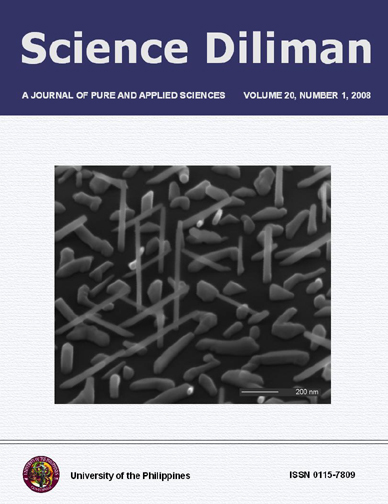Polyclonal IgG Response of Balb/c Mice to the 23 kDa Antigen of <i>Entamoeba histolytica</i>
Abstract
Entamoeba histolytica is one of the most significant protozoan pathogens found in developing countries like the Philippines. This intestinal parasite causes the disease amebiasis, which has a yearly average mortality of about 100,000 people worldwide. Thus, it is essential to develop new diagnostic markers and possible treatment against this disease. The crude cell extract of E. histolytica, was used to induce polyclonal antibody response in mice. Balb/c mice were given immunizations of the prepared crude E. histolytica antigens for a period of twelve weeks. Indirect fluorescent antibody test showed the specificity of polyclonal IgG in recognizing the cytosolic components of E. histolytica trophozoites. Enzyme-linked immunosorbent assay was performed to determine the antibody titers in sera collected at various time intervals. Antibody titers for the mouse serum taken 10 and 20 days after the third booster immunization were known to be 16,384 and 4,096 respectively. SDS-PAGE profile of the crude E. histolytica antigens revealed three bands with molecular weights of 23, 41, and 47 kDa. Western immunoblot results indicated that the polyclonal IgG produced by mice targets the potentially novel 23 kDa antigen from an axenic E. histolytica culture.
Published
2008-11-27
How to Cite
SANTOS, Herbert J.; MAIQUILLA, Sheena Marie B.; RIVERA, Windell L..
Polyclonal IgG Response of Balb/c Mice to the 23 kDa Antigen of Entamoeba histolytica.
Science Diliman: A Journal of Pure and Applied Sciences, [S.l.], v. 20, n. 1, nov. 2008.
ISSN 2012-0818.
Available at: <https://journals.upd.edu.ph/index.php/sciencediliman/article/view/1134>. Date accessed: 05 sep. 2025.
Issue
Section
Articles
Keywords
amebiasis; <i>Entamoeba histolytica</i>; IgG; immunoblot; indirect fluorescent antibody test; polyclonal antibodies
Submission of a manuscript implies: that the work described has not been published before (except in the form of an abstract or as part of a published lecture, review, or thesis); that it is not under consideration for publication elsewhere; that its publication has been approved by all co-authors, if any, as well as by the responsible authorities at the institute where the work has been carried out; that, if and when the manuscript is accepted for publication, the authors agree to the automatic transfer of the copyright to the publisher; that the manuscript will not be published elsewhere in any language without the consent of the copyright holders; that written permission of the copyright holder is obtained by the authors for material used from other copyrighted sources; and that any costs associated with obtaining this permission are the authors’ responsibility.



